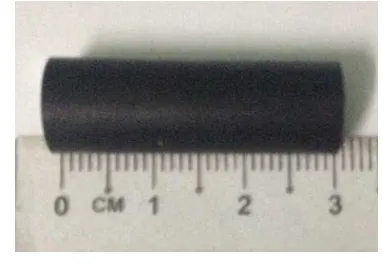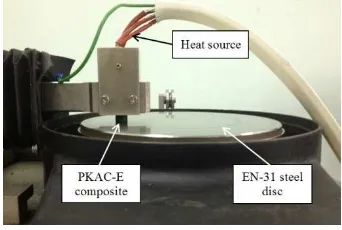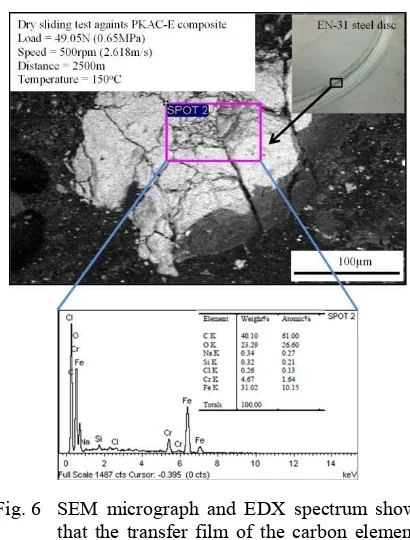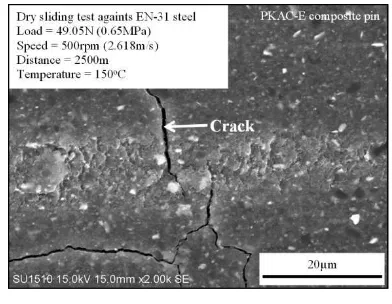Short Communication
The Effect of Temperature on the Tribological Properties of Palm Kernel
Activated Carbon-Epoxy Composite
Noor Ayuma Mat Tahir1), Mohd Fadzli Bin Abdollah1,2)*, Rafidah Hasan1,2) and Hilmi Amiruddin1,2)
1)
Faculty of Mechanical Engineering, Universiti Teknikal Malaysia Melaka Hang Tuah Jaya, 76100 Durian Tunggal, Melaka, Malaysia
2)
Centre for Advanced Research on Energy, Universiti Teknikal Malaysia Melaka Hang Tuah Jaya, 76100 Durian Tunggal, Melaka, Malaysia
*Corresponding author: [email protected]
( Manuscript received 21 December 2014; accepted 27 June 2015; published 31 December 2015 ) ( Presented at the 3rd Malaysia-Japan Tribology Symposium in Kuala Lumpur, November 2014 )
The aim of this study was to investigate the effect of temperature on the tribological properties of Palm Kernel Activated Carbon-Epoxy (PKAC-E) composite. All specimens were formed into 10 mm diameter pins of 30 mm length, using a hot compaction technique. Tribological testing was carried out using a pin-on-disc tribometer in dry sliding conditions by applying temperatures in the range of 27°C to 150°C, at constant sliding speed, applied load, and sliding distance. The results showed that both coefficient of friction (COF) and wear rate of the composite increased with operating temperatures. Abrasive wear and crack formation that would induce delamination wear were identified as the predominant wear mechanisms.
Keywords: palm kernel activated carbon, aste materials, emperature, riction, wear
1. Introduction
Friction and wear are response acts of describing the contact of bodies in tribological aspects. Although friction and wear are related to each other in each state of contact with a system; it is not a simple relationship. Previous tribology studies have introduced several successful methods of controlling wear, such as film coating, multi-phase alloying, and composite structuring; as an addition to lubrication [1,2]. Wear can be further reduced by understanding the wear mechanisms to confirm the tribological characteristics of materials in terms of surface roughness, hardness, ductility, reaction conditions, and adhesive / abrasive transfer [1,3].
Previous researchers suggested several methods to reduce friction and wear by achieving an effective lubrication of all moving components (with minimum adverse impact on the environment), such as monitoring the wide range of operating conditions of load, speed, temperature, and chemical reactivity [4]. This would result in improvements in the tribological performance of engines, and consequently yield lower fuel and oil consumption, higher engine power output, reduced harmful exhaust emissions, better durability, reliability,
engine life, lower maintenance requirements, and longer service intervals.
Besides using lubricating ideas, researchers also investigated the potential of metal matrix composites (MMC). This is because MMC can provide enhanced properties over monolithic materials, such as higher strength, stiffness and is much lighter. MMC has also shown significant improvements in tribological properties, including sliding wear resistance. Regardless of this, Singh and Chuahan [5] found that the incorporation of solid lubricant particles such as partial reinforcement in aluminium matrix increases the wear resistance of composites. Zhai et al. [6] also found that grain nano particles reinforced with aluminium has great potential applications as an effective solid lubricant for moderate loads and stress and can be easily used for the preparation of self-lubricating composites.
low coefficient of friction and high temperature stability. However, PTFE shows poor wear and abrasion resistance. The wear resistance of PTFE can be significantly improved by the addition of suitable filler materials. In the past, researchers had studied PTFE filled with conventional filler materials like glass fibers, graphite, and carbon fibers [9]. However, those studied are also not enough to ensure that PTFE can sustain the functionality of the replaced materials without compromising the life cycles and its functions. Hence, significant effort is needed for developing novel composite materials by adding non-conventional filler materials possessing the potential of increasing wear resistance.
Recently, a substantial amount of research has shifted focus from monolithic materials to composite materials, in order to meet the global demand for lightweight, high performance, eco-friendly, wear and corrosion resistant materials. The advantages of composite materials are their permeability, cost effectiveness, and different strengthening mechanisms [10-12].
The potential of local waste materials as reinforcement substitutes in the fabrication of lightweight materials, such as metal matrix composites and polymer matrix composites, have attracted a great deal of attention from researchers; due to their self-lubricating properties and adoption of a zero waste strategy at an affordable cost [13-18]. Zamri et al. [13,14] found that graphite and porous carbon (also
activated carbon materials as a new material for tribological applications. This fundamental study therefore aimed to further investigate the tribological effects of Palm Kernel Activated Carbon-Epoxy (PKAC-E) composite at different temperatures.
2. Methodology
2.1. Specimen preparation
In this study, the materials used were PKAC and high density epoxy (West system 105 epoxy resin 105-B) and slow hardener (West system 206-B). The PKAC was blended using a blender and sieved with a 1 mm sieve. The residual material (i. e., bigger than 1 mm) was re-blended and re-sieved. The fine PKAC
Fig. 1 Photo of PKAC-E composite after curing
process
Properties a Pin (70 mass% PKAC+30 mass% Epoxy) b Disc (EN-31 (AISI52100) high carbon alloy steel)
Hardness, H [GPa] 8.83 7.9
Porosity, [%] 1.21 -
Density, ρ [g/cm3] 1.35 7.81
a
Properties from laboratory measurements.
b
Properties from manufacturer.
(size ≤ 1 mm) were then weighed by 70 mass% and mixed with epoxy 30 mass% (at a ratio of 4 : 1; resin: hardener). The mixed PKAC and epoxy were then placed in a mould, hot-pressed at 80°C and 2.5 MPa of compression pressure for about 10 minutes, and left to cool at room temperature for about 10 minutes before being pressed out. The pin specimens, sized 10 mm in diameter and 30 mm in height, were left to cure at room temperature for about a week. Figure 1 shows the specimen used in this study.
The density, surface roughness and hardness of the specimen were measured using densitometer, profilometer and Shore Hardness Durometer-D type, respectively. Besides, the porosity was measured based on the Archimedes principle.
2.2. Pin-on-disc test
The dry sliding test was performed, following ASTM standard [20], using a pin-on-disc tribometer. The disc was made from bearing material of EN-31 (equivalent to AISI52100) high carbon alloy steel. All tests were performed under different temperatures ranging from 27°C to 150°C at a constant sliding speed of 500 rpm (2.618 m / s) of 100 mm diameter of sliding track, applied load of 49.05 N (0.62 MPa), and a sliding distance of 2500 m. The heat was supplied and measured to the pin specimen. The average surface roughness of the pin specimen was about 0.40 µm ± 0.02; while for the disc, it was about 0.13 µm ± 0.02. The mechanical properties of the pin specimens and discs are shown in Table 1.
Prior to the sliding test, the disc specimen was cleaned using acetone in an ultrasonic bath. The pin was then mounted vertically on the tester arm at one end and the other pin surface was held against the rotating disc. The schematic diagram of the pin-on-disc tribometer and the actual placement image are shown in Figs. 2 and 3. Test conditions are summarized in Table 2.
The coefficient of friction (COF) and frictional force were measured using a personal computer (PC) based data logging system. The formula used was as follows:
/
F W
(1)
Where, µ is the COF, F is the frictional force in unit N, and W is the applied load in unit N.
It was assumed that the disc had negligible wear, as there was no change in its weight. The wear of the pin was recorded by measuring the mass of the pin before and after the pin-on-disc test. The mass loss was determined by taking the difference in mass, and the mass loss (in mass units) was converted to volume by dividing the bulk density of the specimen. The specific wear rate was determined as follows:
/
Table 2 Dry sliding test operating parameter
Fig. 2 (a) Schematic diagram of a pin-on-disc
tribometer and (b) illustration of the specimen placement
composition was determined using Energy-Dispersive X-ray spectroscopy (EDX).
3. Results and discussion
3.1. Friction and Wear Properties
From Figs. 4 and 5, it is clearly seen that the COF increased rapidly with operating temperatures. This might be due to frictional heating and failure of the epoxy bond. However, starting at 120°C, the COF seemed to be constant in the range of 0.7 to 0.8. It is believed that tribofilm starts to form on the counter surface after 120°C. Figure 6 clearly shows that the transfer film of the carbon element is generated at the counter surface. The transfer film of carbon materials is formed on the counter surface and helps to stabilize the friction between the surfaces. The tribofilm, generated from the preferential wear of the soft carbon material, results in a carbon based tribofilm adhering to the counter surface, which breaks the adhesive joints between the asperities and subsequently leads to a low or maintained friction [16,21].
Figure 7 shows a graph of specific wear rate against temperature. The wear rate gradually increases with temperature. It is believed that as the temperature increases, there is a thermal activated process between the PKAC and the epoxy in the composite. The thermal activated process occurred because of the thermal degradation of epoxy binder which was paralyzed and oxidized. It degraded as gasses and other degraded products. This situation resulted in a decrease in material hardness, which could potentially increase wear. From Fig. 8, it can be seen that the average hardness of the PKAC-E composite began to decrease after the 90°C operating temperature. At 150°C, the PKAC-E lost almost 30% of its original hardness. This was supported by Brostow et al. [22], who found that temperature had a direct impact on the wear of polymers.
3.2. Wear Mechanisms
Not much wear was observed on the pin surfaces below 60°C. Figure 9 shows the wear track of the PKAC-E composite at 90°C. It is clearly seen that parallel groves were formed by abrasive wear, which caused roughening of the test pin surface and resulted in rapid increases of COF as shown in Fig. 5. However, at high temperatures, specifically at 150°C, surface fatigue occurred with crack formations, as shown in Fig. 10. If
Fig. 4 Coefficient of friction at different operating temperatures of PKAC-E composite
Fig. 5 Average steady state coefficient of friction of PKAC-E composite at different operating temperatures
this situation continued, it would induce delamination wear. Gomes et al. [19] stated that fatigue effects and frictional heating were also responsible for causing surface damage and matrix fracture. Nirmal et al. [7] stated in their review that delamination wear was predominantly due to polymer swelling. Delamination usually occurs with mild signs of pitting, peel off, and cracks in worn surfaces.
4. Conclusion
In conclusion, the results showed that the COF and wear rate of PKAC-E composite increased with operating temperatures. Rapid increase of COF was clearly seen after 90°C due to frictional heating and failure of the epoxy bond. However, starting at 120°C, formation of tribofilm on the counter surface resulted in a constant COF. The wear rate kept increasing because of the thermally activated process which resulted in a reduction in hardness; thus causing the failure of the epoxy element in the composition. Abrasive wear and crack formations that would induce delamination wear were identified as the predominant wear mechanisms.
Acknowledgements
The authors are grateful for the contributions by members of the Green Tribology and Engine Performance (G-TriboE) research group. This research was funded by a grant from the Ministry of Higher Education Malaysia (Grant No.: ERGS / 2013 / FKM / TK01 / UTEM / 02 / 04 / E00016).
References
[1] Findik, F., “Latest Progress on Tribological
Properties of Industrial Materials,” Materials & Design, 57, 2014, 218-244.
[2] Abdollah, M. F. B., Yamaguchi, Y., Akao, T.,
Inayoshi, N., Miyamoto, N., Tokoroyama, T. and Umehara, N., “Deformation-wear Transition Map of DLC Coating under Cyclic Impact Loading,” Wear, 274-275, 2012, 435-441.
[3] Kato, K., “Wear in Relation to Friction - A Review,”
Wear, 241, 2, 2000, 151-157.
Fig. 7 Specific wear rates of PKAC-E composite
at different operating temperatures
Fig. 8 Average hardness of PKAC-E composite at
different operating temperatures
Fig. 9 Optical micrograph of worn surface of the
PKAC-E composite at 90°C
for Graphene Nanoplatlets to Reduce Friction and Wear of Ni3Al Matrix Self-Lubricating Composites,” Wear, 310, 1-2, 2014, 33-40.
[7] Nirmal, U., Hashim, J. and Ahmad, M. M. H. M.,
“A Review on Tribological Performance of Natural Fibre Polymeric Composites,” Tribology International, 83, 2015, 77-104.
[8] Prabu, V., Manikandan, V. and Uthayakumar, M.,
“Friction and Dry Sliding Wear Behaviour of Red Mud Filled Banana Fibre Reinforced Unsaturated Polyester Composites Using Taguchi Approach,” Meterials Physics and Mechanics, 15, 1, 2012, 34-45.
[9] Khedkar, J., Negulescu, I. and Meletis E. I.,
“Sliding Wear Behavior of PTFE Composites,” Wear, 252, 5-6, 2002, 361-369.
[10] Uvaraja, V. C., Natarajan, N., Rajendran, I. and
Sivakumar, K., “Tribological Behavior of Novel Hybrid Composite Materials Using Taguchi Technique,” Journal of Tribology, 135, 2, 2013, 021101-1-021101-12.
[11] Rymuza, Z., “Tribology of Polymers,” Archives of
Civil and Mechanical Engineering, 7, 4, 2007, 177-184.
[12] Nguong, C. W., Lee, S. N. B. and Sujan, D., “A
Review on Natural Fibre Reinforced Polymer Composites,” International Journal of Chemical, Molecular, Nuclear, Materials and Metallurgical Engineering, 7, 1, 2013, 33-40.
[13] Zamri, Y. and Shamsul, J. B., “Physical Properties
and Wear Behaviour of Aluminium Matrix
Mechanics of Second-Phase Deformation and Motion,” Wear, 166, 1, 1993, 41-48.
[16] Alexeyev, N. and Jahanmir, S., “Mechanics of
Friction in Self-Lubricating Composite Materials II: Deformation of the Interfacial Film,” Wear, 166, 1, 1993, 49-54.
[17] Bakry, M., Mousa, M. O. and Ali, W. Y., “Friction
and Wear of Friction Composites Reinforced by Natural Fibres,” Materials Science & Engineering Technology, 44, 1, 2013, 21-28.
[18] Chua, K. W., Abdollah, M. F. B., Tahir, N. A. M.
and Amiruddin, H., “Potential of Palm Kernel Activated Carbon Epoxy (PKAC-E) Composite as
Solid Lubricant : Effect of Load on Friction and
Wear Properties,” Jurnal Tribologi, 2, 2014, 31-38. [19] Gomes, J. R., Silva, O. M., Silva, C. M., Pardini, L. C. and Silva, R. F., “The Effect of Sliding Speed and Temperature on the Tribological Behaviour of Carbon-Carbon Composites,” Wear, 249, 3-4, 2001, 240-245.
[20] ASTM G99-05(2010), “Standard Test Method for
Wear Testing with a Pin-On-Disk Apparatus,” ASTM International, West Conshohocken, PA, 2010, www.astm.org.
[21] Luo, Q., “Tribofilms in Solid Lubricants,” In
“Encyclopedia of Tribology, ” Springer, 2013.
[22] Brostow, W., Kovacevic, V., Vrsaljko, D. and



